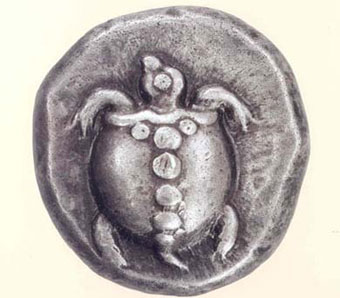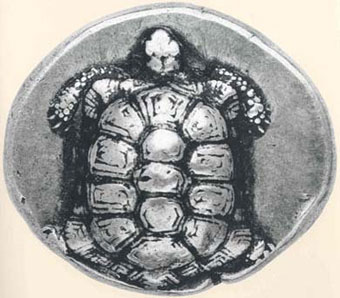Greek Islands Ancient Coins
"Aegina Coin - Silver Stater"
Aegina is an island of high mountains and limited cultivable land lying at the head of the bay of Pireaus, close to the coasts of Attica and the Peloponnese. The inhabitants of Aegina turned to the sea to make a living. The Aeginetan seafarers and merchants founded a trading post at Naukratis in Egypt, and Aeginetan ships sailed the length and breadth of the Mediterranean sea, bearing merchandise and goods. These voyages brought the island wealth and power. The temple of Aphaia dominating the great harbour was decorated with sculptures of high artistic quality.
Coins in the form of tokens first appeared in the area of the east Aegean during the second half of the 7th c. BC, as is clear from the excavations at the temple of Artemis at Ephesos. The invention was carried by Aeginetans to their homeland: Aegina was the first of the Greek cities to strike coins (after 570 BC). Aeginetan staters with a depiction of the sea turtle, which were known as chelones, were struck in great quantities in the 6th c. BC and circulated widely in Greece, in Thessaly, Boeotia, the Peloponnese, the Cyclades, and Crete, and also in the East, as is clear from the study of hoards. The Aeginitenan drachm was called the "thick drachm" by the Athenians, since the Aeginitenan standard was heavier than that of Athens. The source of raw material for these staters was probably the island of Siphnos, whose silver mines were at the height of their production in the 6th c. BC.
The "turtles" (chelones) of Aegina, along with the "owls" (glaukes) of Athens and the "asses" (poloi) of Corinth, were the international currencies of the antiquity.
After the Persian Wars (about 480 BC), the Aegina mint had a smaller output than that of the previous century, as the place occupied by the Aeginetan currency was taken by that of Athens.
Over the following years Aegina lost its domination of the sea and in 457 BC was captured by Athens and became a tribute-paying subject. The change of the numismatic type from sea- to land-turtle must have occurred before the Aeginetans were expelled from their island by the Athenians in 431 BC. At the end of the Peloponnesian War the Aeginetans returned to their island and continued to issue coins with the depiction of the land-turtle. On these coins were inscribed the first three letters of their ethnikon name.







